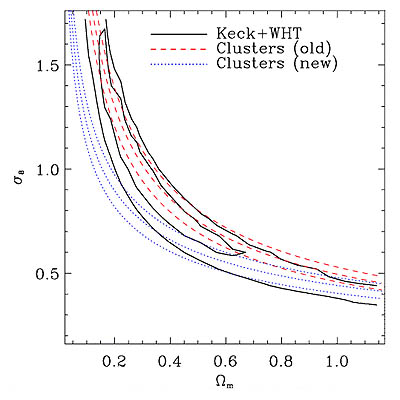|
EXTENDING COSMIC
SHEAR MEASUREMENTS WITH THE WILLIAM HERSCHEL TELESCOPE
WHT+PFC
Weak gravitational lensing of background galaxies by intervening
large-scale structure ('cosmic shear') provides direct information about
the total mass distribution in the universe, regardless of its nature and
state. Thus a measurement of cosmic shear bridges the gap between theory,
which is primarily concerned with dark matter, and observation, which generally
probes only luminous matter. The recent detection of coherent distortion
of faint galaxies using the William Herschel Telescope in 2000 have
triggered great interest in the provision of new constraints on the amount
and distribution of dark matter, together with measurements of several cosmological
parameters.
If intrinsic galaxy orientations are essentially random in a given survey,
any coherent alignment must arise from distortion due to weak lensing.
Light paths from galaxies projected close together on the sky pass through,
and are gravitationally distorted by, the same dark matter concentrations.
This coherent distortion contains valuable cosmological information. In
particular, the variance of the distortion field measures the amplitude
of density fluctuations ( σ 8 Ω0.5m). This shear measurement is
free from assumptions about Gaussianity or the mass-temperature relation, and whilst the
shear-based measurement is currently comparable in precision to that from
local cluster abundance, further progress is limited solely by the number
of fields observed.
σ 8 Ω0.5m). This shear measurement is
free from assumptions about Gaussianity or the mass-temperature relation, and whilst the
shear-based measurement is currently comparable in precision to that from
local cluster abundance, further progress is limited solely by the number
of fields observed.
The validity of results from cosmic shear surveys depends sensitively
on the treatment of systematic errors. A further issue arises from sample
(or 'cosmic') variance, the impact of which can be limited by using numerous
independent sightlines to complement panoramic imaging of a few selected
areas. With these motivations in mind, a team of astronomers compared the
cosmic shear observed with two independent instruments (Keck and William Herschel
Telescope), using two different survey strategies.
Astronomers extended the original detection of the cosmic shear on
the William Herschel Telescope by increasing the number of observed fields,
with a further increase in area as a result of the larger 16×16 arcmin2
size of field with the new prime focus mosaic camera. The aim
of the survey was to acquire deep (z 1) fields representing numerous independent lines of sight, sufficiently
scattered to sample independent structures and thus to minimize uncertainties
owing to sample variance. These lines of sight were chosen in a quasi-random
fashion, without regard to the presence or absence of mass concentrations,
in order to obtain a representative sample of the mass fluctuations in the
universe.
1) fields representing numerous independent lines of sight, sufficiently
scattered to sample independent structures and thus to minimize uncertainties
owing to sample variance. These lines of sight were chosen in a quasi-random
fashion, without regard to the presence or absence of mass concentrations,
in order to obtain a representative sample of the mass fluctuations in the
universe.
The cosmic shear with both Keck and WHT was measured at a signal-to-noise
of 5.1, finding an amplitude of the matter power spectrum of σ 8
(Ωm/0.3)0.68= 0.97 ± 0.13, with 0.14 <Ωm<
0.65, including all contributions to the 68 per cent confidence level uncertainty:
statistical noise, sample variance, covariance between angular bins, systematic
effects and redshift uncertainty. A measurement of this quantity from cosmic
shear is cosmologically valuable, as it represents a direct measure of the
amplitude of mass fluctuations.

|
Constraints on the joint distribution of Ωm
and σ 8 for the combination of Keck and WHT measurements.
[ GIF ]
|
These results for Keck and WHT are consistent with each other, strengthening
confidence in control of systematics. The joint results are also consistent
with other recent cosmic shear measurements. They also agree with the old
cluster abundance normalization. However, they cannot rule out lower cluster-abundance
normalization which has been derived recently. This discrepancy, if confirmed,
could arise from unknown systematics in either the cluster or cosmic shear
methods. For the cluster method, further studies would be needed to understand
the difference between the observed mass-temperature relation and that found
in numerical simulations. It is important to understand the origin of the
discrepancy between cosmic shear and cluster abundance methods. If this is
not explained by such systematics, it could point towards a failure of the
standard ΛCDM paradigm, and therefore have important consequences for cosmology.
Some references:
- Bacon,
D. J., et al., 2000, "Detection of weak gravitational lensing by large-scale
structure", MNRAS, 318, 625.
- Bacon,
D. J., et al., 2003, "Joint cosmic shear measurements with the Keck and William
Herschel Telescopes", MNRAS, 344, 673.
- Irion, R., 2003, "The Warped Side of Dark Matter", Science News, 300, 1894.
|



